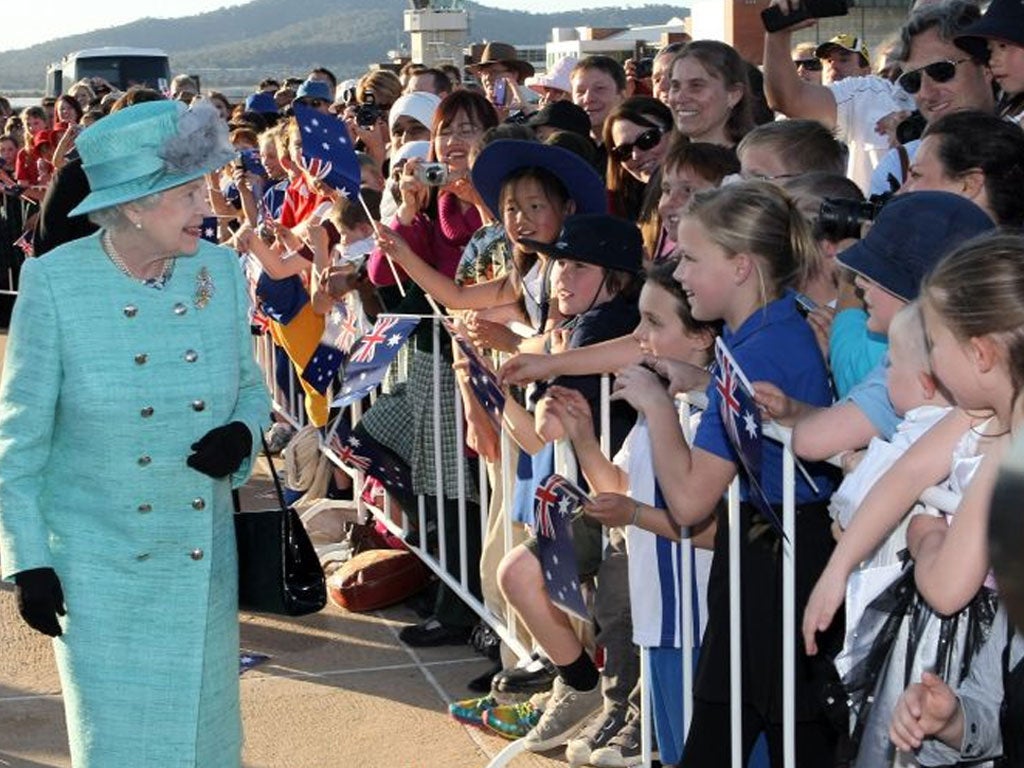Strange death of Australian republicanism
On possibly her final visit, the Queen finds an anti-monarchy movement at its lowest ebb in decades

Little more than a decade ago, Australia seemed poised to reject the British monarchy in favour of a home-grown head of state. But as the Queen embarks on her 16th visit to one of the farthest-flung members of the Commonwealth, the prospect of an Australian republic seems more distant than ever.
A recent poll found that only 34 per cent of Australians support constitutional change, the lowest figure for 20 years, while 55 per cent favour the status quo. That is a near reversal of the situation in 1999 when, in the run-up to a referendum on becoming a republic, 54 per cent of Australians said they wanted reform and just 38 per cent backed retaining the monarchy.
The failure of that referendum, attributed to a split in the republican camp, marked the start of a downturn in the fortunes of the anti-monarchists. Although it had been at the forefont of debate for much of the 1990s, the issue had never aroused as much passion as, say, asylum-seekers or property prices. Australians lost interest, and the conservative government, which remained in power for a further eight years, had no intention of reviving it.
The republican movement shrank, and its leaders, including Malcolm Turnbull, a former lawyer in the Spycatcher case and now a prominent politician, fell silent.
Although the centre-left Australian Labor Party supported a republic, little changed after it was elected in 2007 with the country's prime ministers since then – Kevin Rudd and Julia Gillard – recognising that public affection for the Queen means that there is little prospect of change until her reign ends.
Displays of republican sentiment will, therefore, be muted during the monarch's 10-day visit, which many observers expect to be her last to Australia. That in itself has prompted a wave of nostalgia, with older Australians recalling her first visit in 1954. It was a two-month extravaganza which saw the Queen, then 26, visit 70 country towns as well as every state and territory capital apart from Darwin.
Ms Gillard failed to curtsey on greeting the Queen at Canberra's RAAF Fairbairn airfield last night, instead bowing her head. But the Prime Minister has made clear that the monarch and Duke of Edinburgh are welcome in Australia. "Visits by the Queen are etched into the collective memory of the Australian people," she said when announcing the tour.
Any protests are likely to be small in scale. Activists from Peta (People for the Ethical Treatment of Animals), which objects to the bearskin hats worn by Buckingham Palace guards, gathered at Canberra Airport yesterday but were dispersed by police. In Melbourne, which is on the Queen's itinerary, demonstrators claiming to be inspired by the Occupy Wall Street protests have threatened to disrupt the visit.
The public's fondness for the Queen is not the only obstacle facing republicans. The younger members of the royal family, particularly Prince William and his new, photogenic wife, Kate Middleton, have boosted the monarchy's popularity. The Prince's visit to flood-affected areas of Queensland earlier this year endeared him to many Australians.
The 1999 referendum failed mainly because of disagreement among republicans about whether a president should be elected by parliament or by the people. Those who favoured the latter were overruled, and were so upset that they urged Australians to reject a republic. As a result, only 45 per cent voted yes, and since then the issue has been considered politically poisonous.
Mike Keating, chairman of the Australian Republican Movement, acknowledged the interest surrounding the Queen's trip. He added: "Hopefully, people will pause to consider that we have absolutely no say in who our head of state is, and ask themselves whether a constitutional monarchy is appropriate for Australia in 2011."
Royal ups and downs
1954 Mariner Lieutenant James Cook first claimed the east coast in the name of King George III in 1770, but no monarch set foot in Australia until Queen Elizabeth II made her first visit in 1954. Her eight-week tour was so extensive that about 75 per cent of the population saw her.
1993 Support for the monarchy slumped as all references to the Queen were removed from the Australian Oath of Citizenship. A year on, Prince Charles was the victim of an assassination attempt during a state visit.
2010 A poll found that 45 per cent of Australians were in favour of the Queen remaining Australia's head of state, but that figure rose to 51 per cent if it was guaranteed that Prince William would succeed her instead of his father.
Subscribe to Independent Premium to bookmark this article
Want to bookmark your favourite articles and stories to read or reference later? Start your Independent Premium subscription today.

Join our commenting forum
Join thought-provoking conversations, follow other Independent readers and see their replies